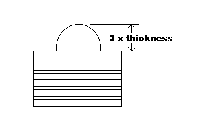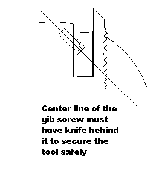One key thing to remember
is that whenever you change knife steel grade, it is very likely that
you will have to change the grinding wheel being used. In some cases,
changing the speed of the grinding wheel will still produce a high quality
knife.
Knife steel is available in many grades. The correct use of each steel
is related to its grade and characteristics. The most important characteristics
to be concerned with include:
Flatness - Bowed steel is a good indication of problems in the manufacturing
process, normally in the heat treating of the steel. This can cause
major problems with maintaining proper balance of the steel. Corrugation Alignment- The trueness of the corrugation is critical.
Verify that the steel has its bottom corrugation true along the entire
length of the knife bar. In the past, some manufacturers have supplied
knife steel that would gain a complete corrugation over the 25 inch
length of a standard bar. This causes severe balance problems and makes
it impossible to grind accurate knives. Corrugation design- After many years of using different knife steels,
it has been proven that the corrugations should not come to a perfect
point. All corrugations should have a slight flat on their top. This
will insure that the knife is held tightly in place against the sides
of the corrugations. If the knife has an exact point on it, it requires
that the head body also have an exact point and that no contamination
is present in the head body. Heat treating- The method used for heat treating is one of the most
critical processes in the manufacture of knife steel. There are many
types of heat treating processes. What is most important to the end
user is the consistency of this process. Every bar of knife steel must
be the same. If you are using a knife steel that grinds different each
time a new bar is used then the heat treating of the stock may be a
concern. Improper heat treating will create hard and soft spots in the
knife material and this makes it almost impossible to produce quality
knives. Availability- No knife steel will work if you can not get it when
you need it. Cost effectiveness- This does not mean that the cheapest
is the best. Factors such as grind time and run time on the machine
must be considered when deciding on a knife steel program.
- back
SAFETY OF
THE STEEL AND ITS USE
 MAXIMUM
DEPTH OF PROFILE MAXIMUM
DEPTH OF PROFILE
It is important to use the correct knife thickness
for the application that the tool is being prepared for. Most knife
steels are available in 1/4”, 5/16” and 3/8” thicknesses. The depth
of cut should never exceed 3 times the thickness of the tool.
If you are using 1/4” steel this means that no
more than 3/4” of steel should be ground into the profile. When using
5/16” this goes up to 15/16” and with 3/8” steel the maximum depth is
1-1/8”.
MAXIMUM KNIFE PROJECTION
No matter what type of knife stock you are using,
never exceed the safe limit of the knife when installing it into the
head body. Most head bodies use the base of the gib as the limiting
point of knife projection. Never extend the knives out past where the
gib screw is pressing against the full corrugation of the knife. This
can damage the head and release the knives.
MACHINE RPM
It is necessary to check the rpm
of the tool being used to the rpm of the machine that tool is being
run on. Some tools are rated at 6,000 rpm, while others are rated at
9,000 rpm. Check to make sure the tool will work on your machine. The
tool must also be dynamically balanced to your RPM.
- back
Unless otherwise stated, all corrugated
knife steel will be 16-60. This means that the corrugations are 1/16”
apart and have a 60 degree angle on them. It is not recommended to substitute
16-90, (1/16 between corrugations with a 90 degree angle of the corrugation)
corrugated steel for 16-60 or visa versa. Use the correct style for
the heads you are using. Be sure to properly install and secure the
knives in your cutterheads.
Select your knife steel carefully. Consider what
the profile will be used for and how often the profile will be reused.
This will help you in determining which grade of steel to select. In
open pockets of the cutterhead use filler stock.
 The
black section shows a 90 degree corrugated cutter head. The gray area
is a 60 degree corrugated knife. When this 60 degree knife is installed
into the 90 degree head body, the knife is not properly locked. The
knife is not as stable as it should be. This can cause the loss of accuracy.
When attempting to increase the feed rate, this is very important. Under
a jointed type production, the knife can vibrate. This will not allow
the knives to stay completely tight. The
black section shows a 90 degree corrugated cutter head. The gray area
is a 60 degree corrugated knife. When this 60 degree knife is installed
into the 90 degree head body, the knife is not properly locked. The
knife is not as stable as it should be. This can cause the loss of accuracy.
When attempting to increase the feed rate, this is very important. Under
a jointed type production, the knife can vibrate. This will not allow
the knives to stay completely tight.
When the angle in the cutter
head body and on the knife match they will fit properly on the edges.
The knife steel should have a slight flat so that the steel is held
in place by the edges of the knife not the point of the knife.
- back
The importance of balanced tools can not be overstated.
A slight mis-balance of any part of the tool can cause a major vibration.
This results in chatter and other finish problems, as well as machine
damage such as bearing failure and spindle misalignment.
When balancing the tools, all parts must be checked.
The gibs should be balanced as a set. Note: If using dual hook angle
heads, keep gibs and pockets matched. The gib screws should be checked.
The knives should be balanced.
 Use
a Harvard Trip Balance as shown below, for easy balance. The scale should
be zeroed before each use. Keep the balance in a clean place for storage
and in a non-windy place while in use. The use of an electronic scale
is also common. It should be noted that when cutting steel a magnetic
force can be created. This can cause the scale to misread. Use
a Harvard Trip Balance as shown below, for easy balance. The scale should
be zeroed before each use. Keep the balance in a clean place for storage
and in a non-windy place while in use. The use of an electronic scale
is also common. It should be noted that when cutting steel a magnetic
force can be created. This can cause the scale to misread.
A tool that is improperly balanced will increase
cost of operation as well as increase operator frustration.
The rotational force that is put onto the machine
spindle is extreme. For example, at 6,000 rpm a single part of the tool
being out of balance by 1 gram is equal to a 22 pound bowling ball being
spun in a circle over your head. This 1 gram can come from a gib screw,
a gib, a knife, a backing plate, the head body or from dust and chips
collected during the operation of the tool.
After the tool has been used and the knives are
removed from the head body, rebalance them before reinstalling them
into the head. It is also suggested that the gibs in the head body be
numbered, as well as the knives. This way the knives can be put back
into the same pocket of the head body. This will reduce the amount of
possible error caused by corrugation differences.
A log book can also be used to record
which head body the knives were used in. If a problem such as chatter
exist when ever the same cutter is used or when the same head body is
used then that part of the tool can be checked for balance.
- back
|


 The
black section shows a 90 degree corrugated cutter head. The gray area
is a 60 degree corrugated knife. When this 60 degree knife is installed
into the 90 degree head body, the knife is not properly locked. The
knife is not as stable as it should be. This can cause the loss of accuracy.
When attempting to increase the feed rate, this is very important. Under
a jointed type production, the knife can vibrate. This will not allow
the knives to stay completely tight.
The
black section shows a 90 degree corrugated cutter head. The gray area
is a 60 degree corrugated knife. When this 60 degree knife is installed
into the 90 degree head body, the knife is not properly locked. The
knife is not as stable as it should be. This can cause the loss of accuracy.
When attempting to increase the feed rate, this is very important. Under
a jointed type production, the knife can vibrate. This will not allow
the knives to stay completely tight. 
 Use
a Harvard Trip Balance as shown below, for easy balance. The scale should
be zeroed before each use. Keep the balance in a clean place for storage
and in a non-windy place while in use. The use of an electronic scale
is also common. It should be noted that when cutting steel a magnetic
force can be created. This can cause the scale to misread.
Use
a Harvard Trip Balance as shown below, for easy balance. The scale should
be zeroed before each use. Keep the balance in a clean place for storage
and in a non-windy place while in use. The use of an electronic scale
is also common. It should be noted that when cutting steel a magnetic
force can be created. This can cause the scale to misread.